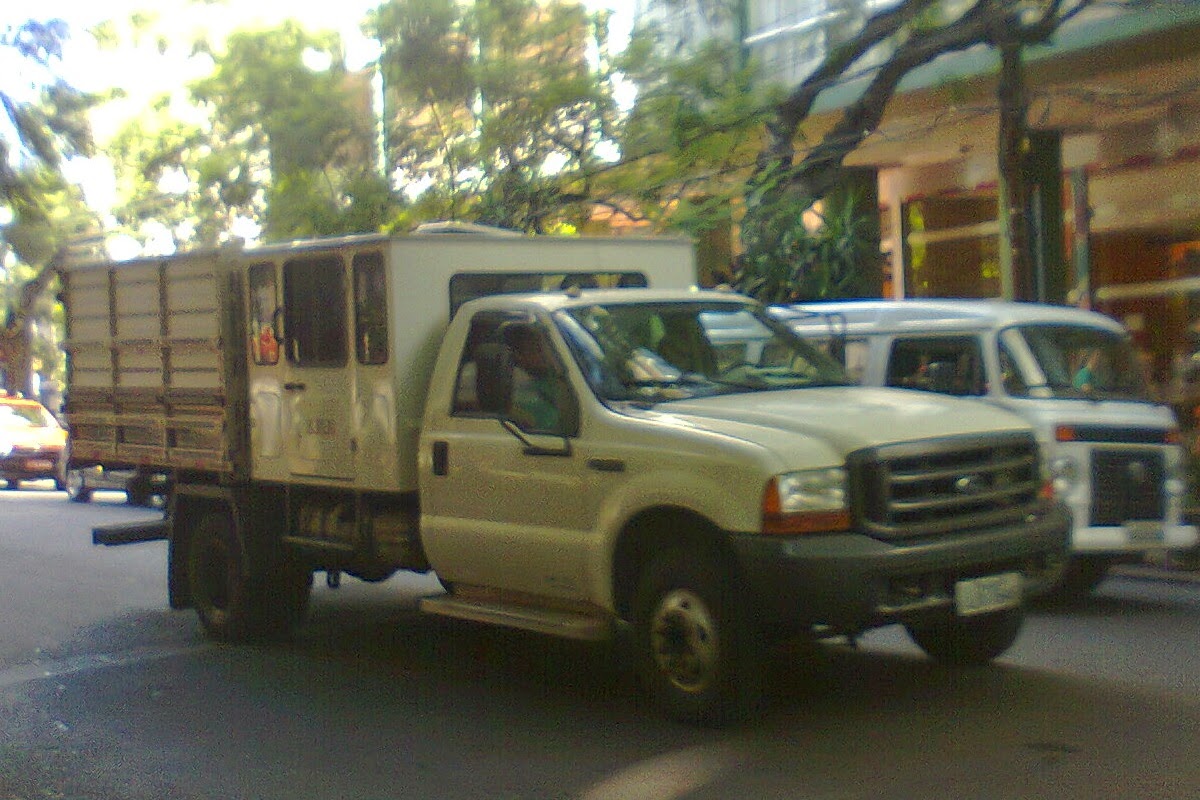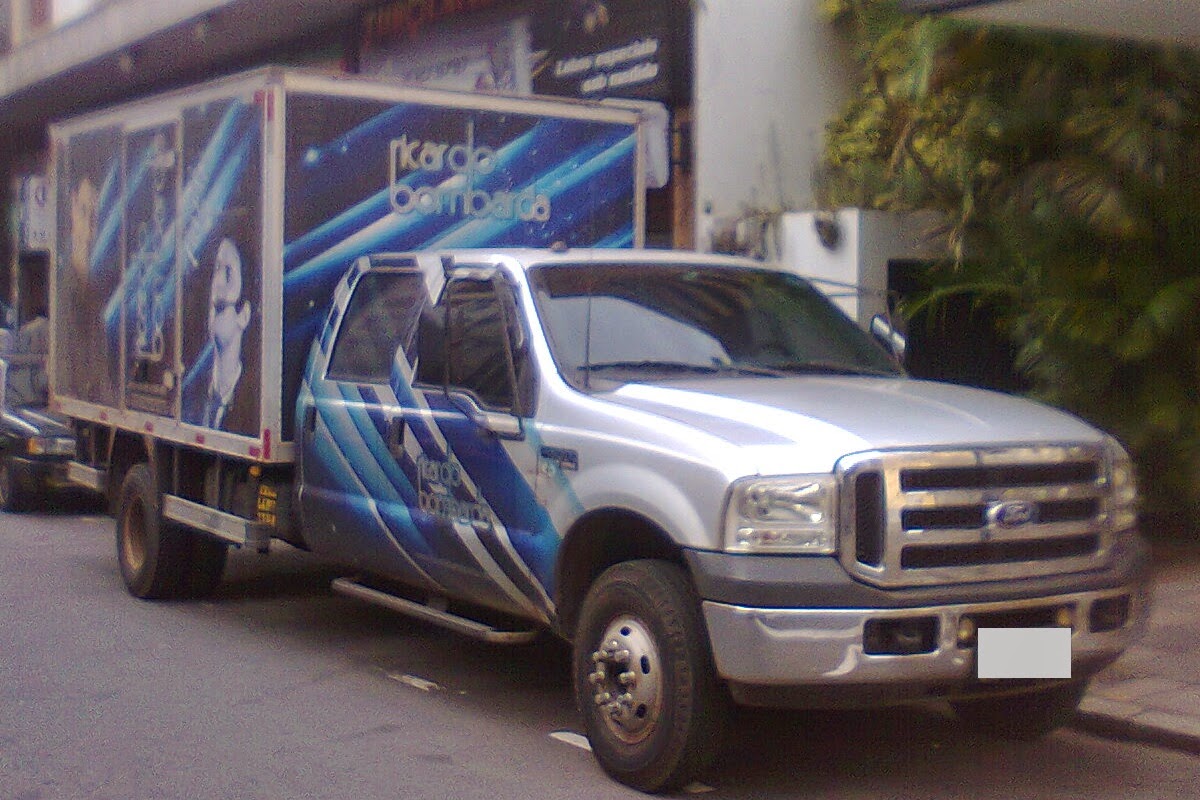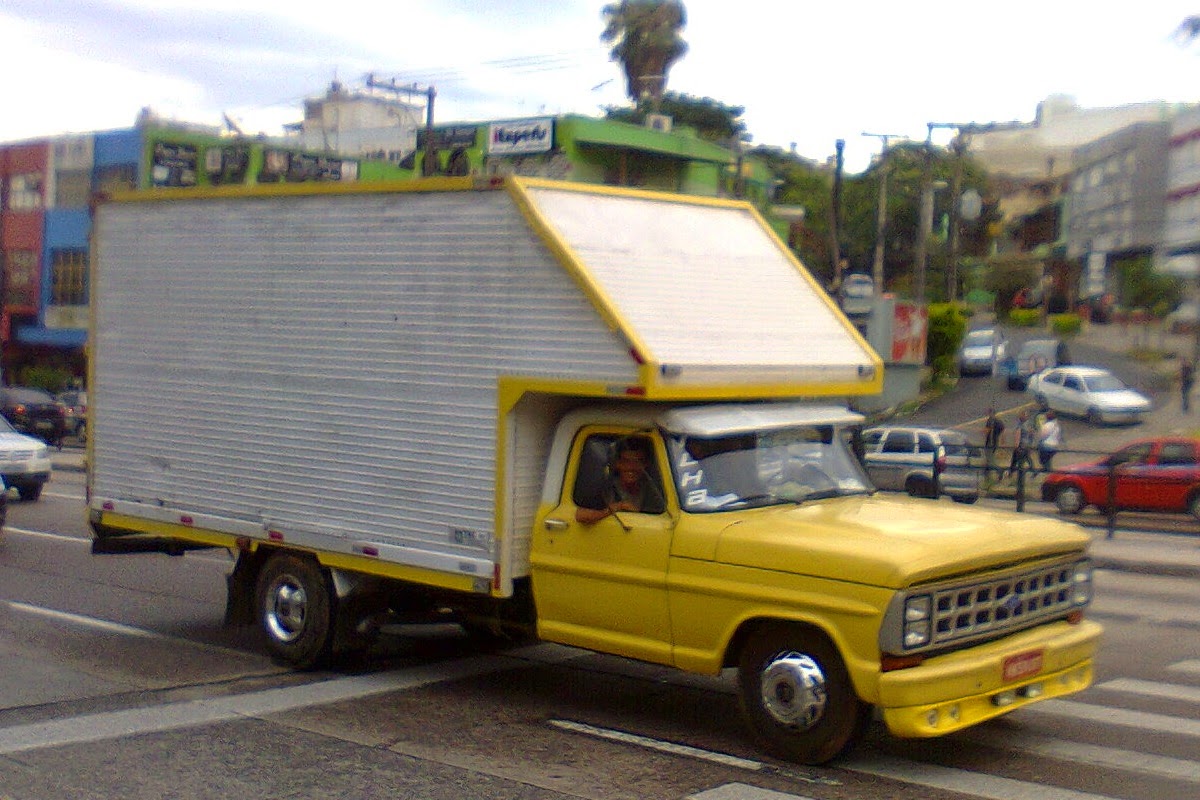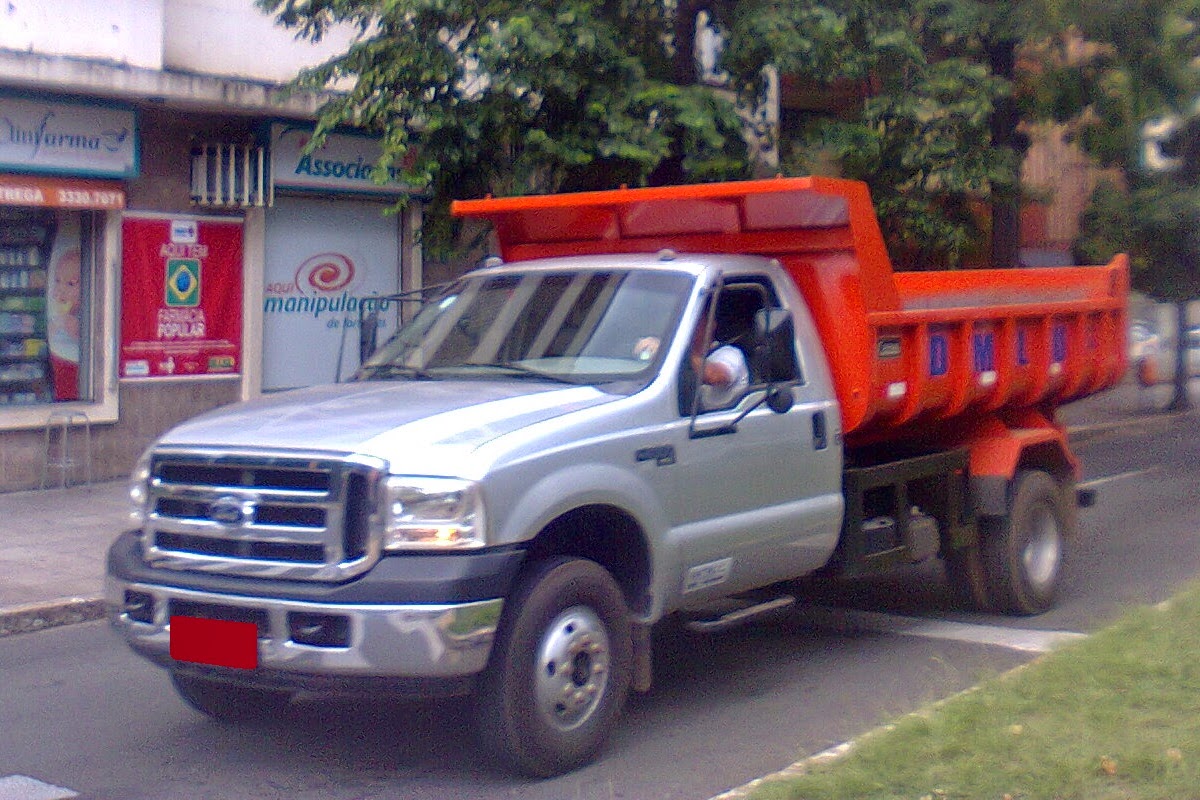This tricycle was assembled in Brazil, and is based in a random Chinese imitation of the Honda CG 125. Spotted in Itapema city, Santa Catarina state.
The front suspension is reinforced, like it's done in some
motorcycle-based cargo tricycles, and a rear extension was added without
any cut in the original chassis, making this conversion somehow easily
reversible.
Monday, December 22, 2014
Saturday, December 06, 2014
4-cylinder turbodiesel engines into trucks: suitable to America?
Nowadays, even a full-size such as a Ford F-450 fitted with a Cummins B3.9 (the good old 4BT) can be as throttle-responsive as one fitted with a gasser V8, no wonder this was the only engine available for a South American equivalent of the F-450 from late '98 to 2011. The cost of a V8 Diesel engine, such as the ones used in North America, would be too high for Brazilian buyers, who couldn't afford the Diesel option as a premium feature.
Historic competition between Mercedes-Benz LN trucks and the F-Series in the Brazilian market is often pointed as the main reason leading Ford to move towards 4-cylinder Diesels in the 70's. Mercedes-Benz not just got a clear advantage due to the parts commonality of its OM-314 engine with the OM-352 used in medium-duty trucks and bus frames but also because these engines were also supplied to other OEMs which fitted it into stationary/industrial appliances and special machinery, making the availability of spare parts easy, and Ford couldn't get a constant supply of any Diesel V8 similar to the International 6.9L IDI used in the United States, so the quickest solution was to fit the agricultural 4.4L engine into the trucks, with a locally-sourced MWM D-226-4 (lately a D-229-4) also available.
MWM would eventually become a Navistar company, and make the V8 engines in Brazil to fit them into International medium-duty trucks and RHD versions of the F-250 and F-350 exported to Australia, but for the versions aimed for sale in Brazil and other regional export markets Ford would keep the 4-cylinder engines, which became supplied exclusively from Cummins in late '98.
What could be pointed as a downgrade exclusive for the Third World, however, is getting attention from Americans who are becoming kinda tired of wasting their money for that one-size-fits-all deal. The increasing complexity of the V8 turbodiesels, which became more targetted to private users, and the sky-high premium cost they're charged for, is leading to some changes in the perception of 4-cylinder engines among the customers, and taken more seriously as a viable option by people who just seek for a no-frills workhorse instead of a fancy "redneck limo" to show off.
Anyway, a 4-cylinder turbodiesel can be a good choice even for a leisure-oriented truck. The one shown in these pictures is an F-250 (not an Excursion) made in Brazil, factory-fitted with a 203hp common-rail Cummins ISB3.9 and an Eaton 5-speed manual transmission, with the 6-door SUV bodywork by Tropical Cabines, a company specialized in crew-cab conversions. Actually, very few people who buy a Diesel truck for non-commercial purposes would really care if there's a small 4-banger or a fancy V8 under the hood
Most of these conversions are, actually, deemed illegal because of differences in the emission certifications of the engines and the vehicles, even if a Diesel engine originally fitted to a Class 5 truck has lower emissions than a gasser V8 that could be legally fitted into a Class 2 rig such as a Hummer H2...
Anyway, the so-called "working class heroes" are still more receptive to 4-cylinder turbodiesels, usually taking their current availability in the Japanese cab-forward trucks such as the Mitsubishi Fuso Canter as a reference of their suitability to the needs of an American operator. So, since U.S.-spec versions of the Canter are fitted with a high-speed 3.0L 4-cylinder turbodiesel outsourced from FPT (Fiat Powertrain), why can't a similar engine become available for a conventional bonnetted-cab truck with a lower GVWR?
Tuesday, December 02, 2014
Has Ford gone too far with the engine downsizing in the Brazilian versions of the SuperDuty?
It ain't breaking news that Ford always used Diesel engines smaller than its American counterparts in the Brazilian F-Series, and lately in the SuperDuty, but it was a shock for many people when it was announced that starting in 2014 the F-350 (picture above, notice the saddle-mounted DEF tank with its blue filling cap) and the F-4000 (a local derivative of the F-450, shown in the picture below with crew-cab and a box-van body) would feature a Cummins ISF2.8 at their engine bay. The current Brazilian version of the F-350, available only in 2WD, is exclusive for the local market, while the F-4000 can be had in either 2WD or 4WD and is also exported to Argentina.
Actually, the F-4000 (the yellow one above might be from the 70's due to the white cabin roof, but got updated with a front clip from the 80's) has been fitted exclusively with a 4-cylinder Diesel since the 70's, and the F-1000 (a derivative of the OBS F-250 with the short bed of the F-150) had a high-speed turbodiesel with a displacement below 3-litre available between '97 and '98 for its 2WD variant, but the F-350 and F-4000 were never factory-fitted with any engine under 3.9-litre such as the Cummins B3.9 (also often referred to as "4BT") which became the sole powerplant for both the F-350 and F-4000 from late '98 to late 2011 when they were phased out because somebody at Ford South American Operations (FSAO) deemed it wouldn't be cost-effective to upgrade them with an electronically-governed engine compliant to Euro-5 emission standards, and trying to push the traditional buyers of the Brazilian F-Series/SuperDuty to the Ford Transit semi-bonnetted vans and the Ford Cargo forward-control truck sounded more profitable. But it was proved wrong and, after losing some market share for Volkswagen, Iveco and even to Hyundai and a few Chinese manufacturers, Ford had to reintroduce the F-350 and F-4000 (pictured below is a '05-'11 F-4000, with a mechanically-governed B3.9 detuned to 120hp in order to get compliant to the Euro-3 emission standards).
In spite of the controversies regarding the new engine, the SuperDuty already recovered its sales performance right after its reintroduction. In a contrast to the American market, where conventional bonnetted trucks remain the most popular configuration, nowadays forward-control trucks are prevalent in Brazil, so the cabin is the strongest sales argument for the F-350 and the F-4000 against its closest competition in the public utility and rural segments. The basic concept of the SuperDuty, less specialized than the current generation of Class 3 and Class 4 cab-forward trucks which are more focused on urban delivery, makes it more favorable for a wide range of operations not just in city and highway but also in rougher terrain.
While it could be deemed kinda obvious to just fit the same engine and transmission from the smaller versions of the Ford Cargo into the F-350 and F-4000 (pictured above is a '98-'05 Euro-2 F-4000 with a Cummins B3.9 rated at 141hp and an aftermarket supplementary cabin), a different engine was chosen, still supplied from Cummins, but for everyone's surprise it was the ISF2.8 instead of the ISBe4.5 currently used in some versions of the Ford Cargo ranging from Class 5 to 7, with its lower cost pointed by a former FSAO engineer as the main factor leading to this choice. It may seem shocking at first, but high-speed turbodiesels in the 2.8L displacement range are actually not so unusual in Asian trucks with a gross vehicle weight rating comparable to the F-4000, such as many Chinese imitations of the Isuzu NPR powered by some copy of the Isuzu 4JB1-TC engine.
OK, with an engine that would predictably develop a lower torque, altough it would do so at a higher RPM, the right gearing selection becomes a major concern in order to retain a reasonable performance. Gears with a numerically higher rating are, actually, lower, because they mean how many input rotations would be turned into output rotations, such as from the engine to the transmission and from the transmission to the rear-end. A higher engine speed compensates for a lower final gear ratio, which is applied to multiply the torque, so it's viable to keep the performance in pair with a lower-speed engine at a higher displacement range coupled to a transmission setup with a higher final gear.
At a first look, it might seem that Ford went too far in the downsizing with the SuperDuty for the Brazilian and Argentinian markets, but actually it does seem to match the specific requirements of the regional market, where the purchase cost is a kinda critical issue, and a Diesel engine must be the standard instead of a premium feature. On a sidenote, unlike its American equivalents which are nowadays available only with an automatic transmission, the Brazilian SuperDuty is factory-fitted exclusively with a manual, not just because of its lower cost but also due to its perceived lower impact on fuel-efficiency and easier repairability.
Actually, the F-4000 (the yellow one above might be from the 70's due to the white cabin roof, but got updated with a front clip from the 80's) has been fitted exclusively with a 4-cylinder Diesel since the 70's, and the F-1000 (a derivative of the OBS F-250 with the short bed of the F-150) had a high-speed turbodiesel with a displacement below 3-litre available between '97 and '98 for its 2WD variant, but the F-350 and F-4000 were never factory-fitted with any engine under 3.9-litre such as the Cummins B3.9 (also often referred to as "4BT") which became the sole powerplant for both the F-350 and F-4000 from late '98 to late 2011 when they were phased out because somebody at Ford South American Operations (FSAO) deemed it wouldn't be cost-effective to upgrade them with an electronically-governed engine compliant to Euro-5 emission standards, and trying to push the traditional buyers of the Brazilian F-Series/SuperDuty to the Ford Transit semi-bonnetted vans and the Ford Cargo forward-control truck sounded more profitable. But it was proved wrong and, after losing some market share for Volkswagen, Iveco and even to Hyundai and a few Chinese manufacturers, Ford had to reintroduce the F-350 and F-4000 (pictured below is a '05-'11 F-4000, with a mechanically-governed B3.9 detuned to 120hp in order to get compliant to the Euro-3 emission standards).
In spite of the controversies regarding the new engine, the SuperDuty already recovered its sales performance right after its reintroduction. In a contrast to the American market, where conventional bonnetted trucks remain the most popular configuration, nowadays forward-control trucks are prevalent in Brazil, so the cabin is the strongest sales argument for the F-350 and the F-4000 against its closest competition in the public utility and rural segments. The basic concept of the SuperDuty, less specialized than the current generation of Class 3 and Class 4 cab-forward trucks which are more focused on urban delivery, makes it more favorable for a wide range of operations not just in city and highway but also in rougher terrain.
While it could be deemed kinda obvious to just fit the same engine and transmission from the smaller versions of the Ford Cargo into the F-350 and F-4000 (pictured above is a '98-'05 Euro-2 F-4000 with a Cummins B3.9 rated at 141hp and an aftermarket supplementary cabin), a different engine was chosen, still supplied from Cummins, but for everyone's surprise it was the ISF2.8 instead of the ISBe4.5 currently used in some versions of the Ford Cargo ranging from Class 5 to 7, with its lower cost pointed by a former FSAO engineer as the main factor leading to this choice. It may seem shocking at first, but high-speed turbodiesels in the 2.8L displacement range are actually not so unusual in Asian trucks with a gross vehicle weight rating comparable to the F-4000, such as many Chinese imitations of the Isuzu NPR powered by some copy of the Isuzu 4JB1-TC engine.
OK, with an engine that would predictably develop a lower torque, altough it would do so at a higher RPM, the right gearing selection becomes a major concern in order to retain a reasonable performance. Gears with a numerically higher rating are, actually, lower, because they mean how many input rotations would be turned into output rotations, such as from the engine to the transmission and from the transmission to the rear-end. A higher engine speed compensates for a lower final gear ratio, which is applied to multiply the torque, so it's viable to keep the performance in pair with a lower-speed engine at a higher displacement range coupled to a transmission setup with a higher final gear.
At a first look, it might seem that Ford went too far in the downsizing with the SuperDuty for the Brazilian and Argentinian markets, but actually it does seem to match the specific requirements of the regional market, where the purchase cost is a kinda critical issue, and a Diesel engine must be the standard instead of a premium feature. On a sidenote, unlike its American equivalents which are nowadays available only with an automatic transmission, the Brazilian SuperDuty is factory-fitted exclusively with a manual, not just because of its lower cost but also due to its perceived lower impact on fuel-efficiency and easier repairability.
Subscribe to:
Posts (Atom)


























